
Coffee is a beverage brewed from roasted coffee beans. Darkly colored, bitter, and slightly acidic, coffee has a stimulating effect on humans, primarily due to its caffeine content. It has the highest sales in the world market for hot drinks.
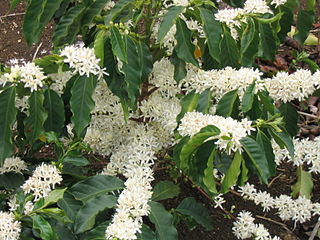
Coffea arabica, also known as the Arabica coffee, is a species of flowering plant in the coffee and madder family Rubiaceae. It is believed to be the first species of coffee to have been cultivated and is the dominant cultivar, representing about 60% of global production. Coffee produced from the less acidic, more bitter, and more highly caffeinated robusta bean makes up most of the remaining coffee production. The natural populations of Coffea arabica are restricted to the forests of South Ethiopia and Yemen.
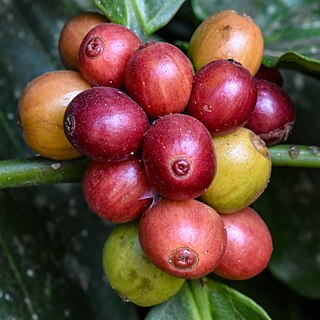
Coffea canephora is a species of coffee plant that has its origins in central and western sub-Saharan Africa. It is a species of flowering plant in the family Rubiaceae. Though widely known as Coffea robusta, the plant is scientifically identified as Coffea canephora, which has two main varieties, robusta and nganda.
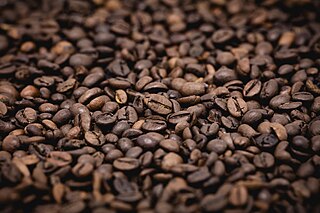
Coffee is a popular beverage and an important commodity. Tens of millions of small producers in developing countries make their living growing coffee. Over 2.25 billion cups of coffee are consumed in the world daily. Over 90 percent of coffee production takes place in developing countries — mainly South America — while consumption happens primarily in industrialized economies. There are 25 million small producers who rely on coffee for a living worldwide. In Brazil, where almost a third of the world's coffee is produced, over five million people are employed in the cultivation and harvesting of over three billion coffee plants; it is a more labor-intensive culture than alternative cultures of the same regions, such as sugar cane or cattle, as its cultivation is not automated, requiring frequent human attention.
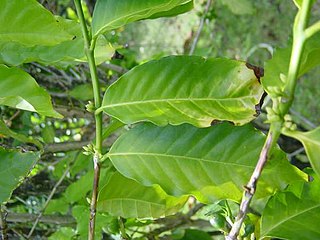
Bourbon is a cultivar of Coffea arabica. It is one of the two main varietals from which many new cultivars are bred, the other being Typica. Both originated in Yemen.

Boquete is a small mountain town in Panama. It is located in the westernmost Province of Chiriquí, about 60 kilometres (37 mi) from the border with Costa Rica, and lies on the Caldera River, in Panama's green mountain highlands. Because of its elevation, some 1,200 metres (3,900 ft) above sea level, its climate is cooler than that of the lowlands. Its scenic location, temperature, and natural environment make it popular with Panamanians and attracts tourists and retirees from all over the world.
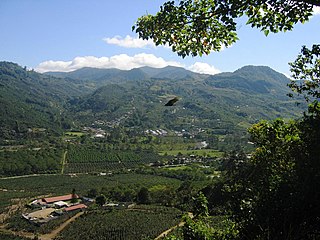
Coffee production has played a key role in Costa Rica's history and continues to be important to the country's economy. In 2006, coffee was Costa Rica's number three export, after being the number one cash crop export for several decades. In 1997, the agriculture sector employed 28 percent of the labor force and comprised 20 percent of Costa Rica's total GNP. Production increased from 158,000 tons in 1988 to 168,000 tons in 1992. The largest growing areas are in the provinces of San José, Alajuela, Heredia, Puntarenas, and Cartago. The coffee is exported to other countries in the world and is also exported to cities in Costa Rica.

Indonesia was the fourth-largest producer of coffee in the world in 2014. Coffee cultivation in Indonesia began in the late 1600s and early 1700s, in the early Dutch colonial period, and has played an important part in the growth of the country. Indonesia is geographically and climatologically well-suited for coffee plantations, near the equator and with numerous interior mountainous regions on its main islands, creating well-suited microclimates for the growth and production of coffee.

Coffee production in India is dominated in the hill tracts of South Indian states, with Karnataka accounting for 71%, followed by Kerala with 21% and Tamil Nadu. Indian coffee is said to be the finest coffee grown in the shade rather than direct sunlight anywhere in the world. There are about 250,000 coffee growers in the country; 98% of them are small growers. As of 2009, Indian coffee made up just 4.5% of the global production, being the 7th largest producer of coffee. Almost 80% of Indian coffee is exported; 70% is bound for Germany, Russia, Spain, Belgium, Libya, Poland, Jordan, Malaysia, U.S.A, Slovenia and Austria. Italy accounts for 20.37% of the exports. Most of the export is shipped through the Suez Canal.

Boquete District is a district (distrito) of Chiriquí Province in Panama located on the North of the Chiriqui Province, in the western side of the country. The population according to the 2010 census was 22,435. The district covers a total area of 488.48 square kilometres (188.60 sq mi).

Gesha coffee, sometimes referred to as Geisha coffee, is a variety of coffee tree that originated in the Gori Gesha forest, Ethiopia, though it is now grown in several other nations in Africa, Asia, and the Americas. It is widely known for its unique flavor profile of floral and sweet notes, its high selling price, and its exclusivity as its demand has increased over the years.

Brazil produces about a third of the world's coffee, making the country by far the world's largest producer. Coffee plantations, covering some 27,000 km2 (10,000 sq mi), are mainly located in the southeastern states of Minas Gerais, São Paulo and Paraná where the environment and climate provide ideal growing conditions.

Laos produces two main types of coffee: Robusta and Arabica. Robusta is mainly used for regular coffee as well as a typical coffee drink in Laos where it is sweetened with condensed milk. The latter, Arabica, is of a higher quality due to its mild taste, and it is used for espresso. For the 20,000 tons of coffee that Laos produces a year, 5,000 tons are Arabica beans and 15,000 tons are Robusta.

Coffee is Uganda's top-earning export crop. In 1989 Uganda's coffee production capacity exceeded its quota of 2.3 million bags, but export volumes were still diminished by economic and security problems, and large amounts of coffee beans were still being smuggled out of Uganda for sale in neighbouring countries. Uganda is one of the few countries in the world with indigenous coffee, with Robusta coffee growing wild around Lake Victoria.
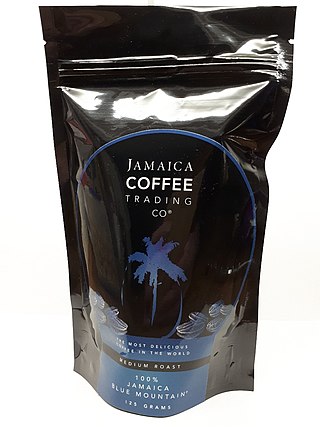
Coffee production in Jamaica began after 1728, when governor Sir Nicholas Lawes introduced the crop near Castleton, north of Kingston. Jamaican Blue Mountain Coffee is the special variety of coffee that is grown in the Blue Mountains region, which has the most conducive climate and topographical features; this variety is known for its scent and sweet taste. Most of Jamaica's coffee production is grown for export.

Coffee production is very important for the economy of Cameroon The crop is grown extensively in the country, with robusta more prevalent in the coastal areas and arabica more widespread in the western highlands. The two varieties of arabica cultivated are Java and Jamaïca of which only Java is resistant to pests such as coffee berry disease and rust. In 2014, Cameroon was ranked the 31st largest producer of coffee in world.

Peru is one of the top 20 coffee producers in the world as of 2014. It ranks fifth in the export of Arabica in the world market.
Benguet coffee, also known as Benguet arabica, is a single-origin coffee varietal grown in the Cordillera highlands of the northern Philippines since the 19th century. It belongs to the species Coffea arabica, of the Typica variety. It is one of the main crops of farmers in the province of Benguet, which has a climate highly suitable for arabica cultivation. Benguet coffee is listed in the Ark of Taste international catalogue of endangered heritage foods by the Slow Food movement.
Ernesto Marco Aníbal Gomezjurado Solórzano better known as Marco Ernesto, was an impressionist Panamanian painter, called "The Palette Knife Master".


















